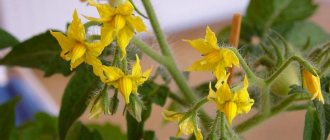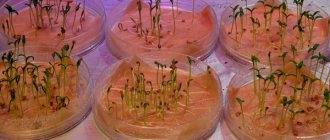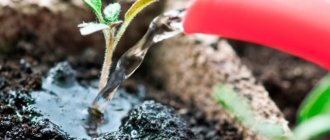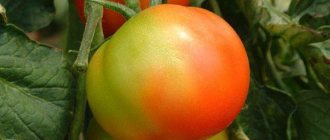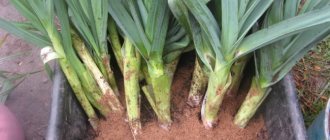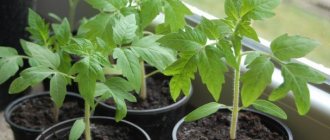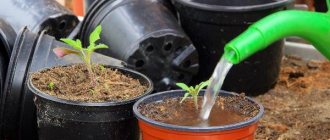Tomatoes are one of the most common crops grown in our garden plots. The plant bears fruit both in greenhouses and in open ground. But, unfortunately, the harvest is not always pleasing. Knowing the commitment of summer residents to the proper cultivation of garden plants, we can say with confidence: lack of care and inadequate farming cannot cause a poor harvest. One thing remains - the low quality of the seeds sold.
How to collect tomato seeds at home
Just as exchange rates are unstable, so are prices for things that gardeners need: gardening tools, fertilizers, seeds.
If it’s a little difficult to decide on the first two things on your own, then we can easily prepare the seeds of many of our favorite plants ourselves.
Today I will talk about how to collect tomato seeds at home. I will give you the simplest, most accessible method. This is how our grandmothers did it.
Seed collection sequence
The process of collecting tomato seeds consists of several stages:
- Selection of fruits for seed collection;
- Soaking the source material;
- Fermentation;
- Washing;
- Drying;
- Bookmark for storage.
What fruits are suitable for collecting seeds?
The issue of selecting fruits for obtaining seeds is very important. Having decided to collect tomato seeds at home,
selection of fruits for seed production is very important
Keep in mind a few important points:
- Not every variety is suitable for collection. Alas, tomato varieties marked F1 will never give you the fruits you expected. The fact is that tomatoes, cucumbers and other plants, on the packets of seeds of which you saw the designation F1 when planting in spring, are artificially bred hybrid varieties. Breeders crossed only known tomato varieties with each other and got the tomatoes you liked. The F1 mark indicates that this is the result of selection of varieties obtained in the first generation. But it is impossible to predict what the offspring will be like in the second. You may end up with either bushes that are simply not the same variety that you planned to plant, or a bunch of plants of different varieties mixed together. The result may be the most unexpected. For example, we had a case: we took some seedlings from friends, and excellent tomatoes grew. We decided to collect seeds. We collected them, preserved them well, sowed them this year, and instead of large fruits weighing half a kilo, we got a huge amount of cherry tomatoes. The tomatoes turned out to be hybrids. Cherry is certainly not so bad, but still not good enough. Therefore, now we collect only those seeds that we know for sure that they reproduce normally in the usual way.
- It is necessary to select fully ripe, even slightly overripe tomatoes. In this case, you can be sure that the seeds in them are also ripe. It’s better if the fruit has some kind of spot that can be cut off without any problems, but not green or brown.
- If you want to preserve a certain variety of tomato, try to select fruits in places where the risk of pollination from bushes of another variety is minimal. In fact, tomatoes are often cross-pollinated. The most interesting thing is that sometimes pollinated tomatoes become even better than before, but to preserve the characteristics of the variety, you shouldn’t take risks or you need to do it consciously.
Main stage: soaking and fermentation
Having selected the fruits, we proceed to obtaining seeds. As I wrote before, I’ll tell you the easiest way. This way you can collect tomato seeds at home in large quantities at once.
- We sort the fruits by variety and prepare several plastic or glass containers for soaking the seeds for fermentation. You shouldn't take metal ones - they oxidize from the juice. Plastic buckets, yogurt cups, cut-off plastic bottles or jars will do. You need several of them to sort the tomatoes by variety.
- We cut the tomatoes into quarters, put them in containers and fill them with water. Pour water so that it covers the tomato pieces.
- Cover the workpiece with film or napkins and place it in a warm, dark place. Leave it like this for a couple of days. Fermentation for a longer period is not recommended. Scientists say that with prolonged fermentation, seed germination deteriorates.
Washing and drying
We are approaching the final phase of collecting tomato seeds at home. It remains to do a few simple procedures:
- After fermentation, remove our containers from the windowsill and add a little water to them. Washing tomato seeds
- Knead the tomato mass and let it stand for a while so that the seeds settle to the bottom. Good seeds will settle, bad seeds will float to the surface.
- We remove the bad seeds and cake, holding the seeds remaining at the bottom of the containers, and drain the water.
- Again, fill the seeds with water and let them stand for 10-15 minutes. Remnants of bad seeds will float to the surface. We remove them and drain the water. We do this until the water becomes absolutely clear.
- Drain the water from the seeds one last time and pour them out to dry. You can dry on paper towels, newspapers or plastic trays.
It is necessary to dry tomato seeds until there is no moisture at all. During the drying process, the seeds will need to be stirred periodically so that they do not stick together and dry better.
When they become completely dry and crumble freely, you can put them in storage. You can store it in bags, plastic bottles, paper bags.
The main thing is that the container is dry, otherwise the seeds may become moldy.
Other ways to collect tomato seeds
We collect seeds using the described method. It’s convenient, and most importantly, you don’t have to deal with picking out seeds with a spoon or any other tricks. But there are other ways to collect tomato seeds at home. I found mentions of them on the Internet, some of them, frankly speaking, surprised me:
- The first method is similar to what I told you. The only difference is that the tomatoes are not cut into pieces, but cut into halves, from which the seeds with pulp are scooped out with a spoon. Then this pulp is soaked for fermentation and then everything is done by analogy. I think this method is not very convenient, because with a spoon you can’t pick out all the seeds from the tomato halves, and in general it’s more hassle.
- Some gardeners pick out tomato seeds from the fruit directly onto paper and dry them directly from
seeds with pulp are selectedpulp, without fermentation. I found this method on one of the American sites. The most interesting thing is that the seeds collected in this way are planted directly in plates of dried pulp - they are buried in the ground and that’s it. I don’t even know what they can do, and I have no desire to try yet.
- The third way to collect tomato seeds is that they are not collected in the classical sense of the word, but they take whole tomatoes and bury them where they want the bushes to grow next year: a small hole is dug, a tomato is placed there and covered with a layer of soil for 2 -3 cm. The whole thing is sprinkled with mulch (grass, leaves) on top and left like that for the winter.
In the spring, the mulch is removed, the soil warms up, and the tomato seeds germinate and sprout. At least that's how it should be.
Perhaps this method works, but in my opinion, the consumption of seeds is too irrational. In addition, many seedlings can sprout in one place and this will not be very convenient to work with.
Although this is theoretical reasoning, I have not tried this method. Maybe in practice it will work out fine.
These are all the options for how to collect tomato seeds at home that I know of. In general, as many gardeners as there are, there are as many opinions as to how best to choose seeds. For example, I came across a video in which a gardening specialist claims that you should not add water during fermentation, saying that the seeds die in water.
Perhaps he is right to some extent, but so far we have obtained tomato seeds with water fermentation quite successfully. What do you think about this? Just in case, I'm attaching this video for you to watch. If you use any of your own methods, tell us about it in the comments. Many people will be interested in this.
Stay in touch!
Video No. 1: how to collect tomato seeds with your own hands
Video No. 2: Step-by-step instructions for obtaining tomato seeds yourself
style=”display:block” data-ad-client=”ca-pub-7849935230341281″ data-ad-slot=”3710725520″
data-ad-format=”autorelaxed”>
Source: https://usadbaplus.ru/kak-mozhno-sobrat-semena-tomatov-v-domashnih-usloviyah/
Selection of fruits for collecting seeds
Tomatoes must be chosen correctly, otherwise high-quality planting material will not work. Which tomatoes are suitable for collecting seeds:
- It is necessary to select seed fruits from well-developed bushes. Plants should not be affected by diseases.
- Fruits should be selected that have a typical size and color for this variety.
- Collect tomatoes for seeds from the lower branches. In this case, there is minimal risk that it is its own hybrid, since during the flowering of the lower branches the activity of the bees is still small, and they will not have time to cross-pollinate the flowers. In the greenhouse, you can pick fruits from the second and third branches. It is not recommended to use tomatoes from the top clusters also because they produce small fruits.
- Green and overripe tomatoes are not suitable for collecting seeds. They should be brown or almost ripe. The tomatoes will ripen at home.
You will be interested to know: How to feed and spray tomatoes for ovary: folk remedies and use of the drug Ovary
How to collect tomato seeds at home?
Who doesn't love ripe and juicy tomatoes from their own garden? The plump sides and pleasant pulp decorate salads, give soups a beautiful taste and aroma, and serve as appetizers on the holiday table. And in our gardens this plant is popular and loved, although its cultivation requires a lot of attention and accuracy.
But growing tomatoes begins, of course, with seeds. We’ll talk about how to approach seed collection correctly in this material. Firstly, only varietal tomato seeds are suitable for future planting, and if you want to purchase ready-made planting material, then remember this once and for all.
True, experienced gardeners do not recommend buying seeds in a store. The most reliable way to get a rich harvest in the future is to use what you have in the present! Choose the healthiest and strongest among your bushes, and on it the most juicy and ripe tomato.
Choose the “parent” of your future crop based on its external characteristics: it must correspond to the description of the variety and have all its distinctive features.
Have you chosen? Don't rush to tear it down. Now that his fate is predetermined, he must overripe and become as soft and fleshy as possible. After our tomato is overripe, we need to pick it and start “evacuating” the seeds: to do this, just carefully cut off the top part and carefully scoop out the pulp, transferring it to a separate cup or other convenient container.
Fill the tomato insides with a small amount of water and cover the top with film, making several small holes in it to start the fermentation process. In this case, the cup with tomato pulp must be in a warm place. When the mixture ferments, the seeds will sink to the bottom, separating from the main mass.
If any individual seeds float to the surface, they must be thrown away; they are “empty” and will not yield a harvest.
Those remaining at the bottom are scooped out into a sieve and washed. If there are a few pieces left that are still inside the pulp, they also need to be washed.
The next stage is to protect the seed from infection. To protect future tomatoes, you need to “bathe” them in a solution of manganese or copper sulfate for half an hour.
But be extremely careful not to burn the delicate shells - the solution should be as weak as possible! Next, the seeds are removed from the disinfectant solution and dried.
The best way to do this is with paper towels: blot the planting material and place it on a cardboard plate. During the drying process, be sure to carefully stir the seeds so that they do not stick together.
Source: https://sadovodka.ru/posts/8959-kak-sobrat-semena-pomidorov-v-domashnih-uslovijah.html
Procurement time
Before collecting seeds from a tomato, you need to determine the optimal timing for this. If harvesting is done too early, the future seedlings will be too weak. And the tomato harvest will be small. But if you delay the best time for harvesting, then next year your seedlings will be infected: it will hardly be possible to harvest from such plants at all.
The optimal time for harvesting tomato seeds is determined by the time of fruit ripening. It is necessary to prepare seed material neither at the beginning nor at the end of the fruiting period. Calculate the golden mean and start collecting. A table will help you with this, which determines the beginning and end of the fruiting period of a tomato crop depending on the type of variety.
| Table of fruiting dates for tomatoes | ||
| Variety type | Beginning of fruiting | End of fruiting |
| Early ripening | Mid July | Mid August |
| Mid-season | Mid August | Beginning of September |
| Late ripening | Beginning of September | End of September |
The table shows that the procurement of early tomato seeds for seedlings should begin at the end of July or at the beginning of August. For a mid-season variety, it is better to postpone the matter until the end of summer. And to collect material for seedlings from late-ripening bushes, you will have to wait until mid-September. But in central Russia, such varieties are not very popular: tomatoes are affected by late blight.
How to properly collect tomato seeds at home
Today there is no problem with purchasing tomato seeds. They can always be purchased in specialized stores. But these seeds are not always of the appropriate quality. Very often, gardeners complain about low germination rates.
If you have favorite and time-tested varieties of tomatoes, then you can prepare the seed yourself.
Why your own seeds are better
Store-bought seeds are packaged in bags. They are often coated or sonicated. All these measures are aimed at improving germination and increasing the resistance of tomatoes to diseases.
Pitfalls in store-bought seeds
- The cost of seeds sometimes does not always correspond to the quality.
- Expiration dates on the label are not always accurate.
- Seeds of your favorite varieties are not always available for sale.
- The number of seeds in the bags is negligible.
Benefits of homemade seeds
- growing tomatoes from your own seeds gives a good harvest, because the plants have already adapted to the characteristics of the region;
- every gardener can get the right amount of seeds;
- it is easy to treat seed material against diseases at home;
- significant money savings;
- ensuring peace of mind: you don’t have to worry about seed germination and seedling quality.
Don't make mistakes
Even a novice gardener can obtain high-quality seed if he carefully reads the tips.
You need to know the rules for collecting seeds, as well as five common mistakes, since not all tomatoes can be collected at home.
Before selecting tomatoes for seeds, you should familiarize yourself with the 5 most common mistakes so as not to be disappointed when using your seeds to grow tomatoes.
It is important:
- You need to collect seeds from varieties, not hybrids. Plants of the new generation not only do not retain their original qualities, but they often produce tasteless or ugly fruits. If the package of purchased tomatoes bears the letter F1, it is a hybrid.
- You cannot take any tomato from the bush. The fact is that bees help pollinate fruits, and they can transfer pollen from other plants growing nearby. For seeds, choose tomatoes that grow on the very first or second tassel, which begin to bloom in May, when bee activity is minimal.
- You should not pick the largest fruits, because they do not always correspond to the variety. Most likely, this size for a tomato is accidental; its maternal qualities are not fully preserved.
- Tomatoes with a typical shape for the variety are suitable for seeds. Experiments in this case are inappropriate: if, according to the description, the fruits are round, then a different shape is more likely the result of cross-pollination.
- Overripe tomatoes are not suitable for collecting seed, as the seeds germinate in them and lose their viability.
Often, gardeners take seeds from store-bought or market-bought tomatoes. It’s easy to check whether they are hybrids or not. You need to sow the seeds and watch the shoots. If all the sprouts are the same, like twins, then you have varietal tomatoes. The seedlings of hybrids will be different. There is no need to use such seeds; it is better to throw them away.
Procurement of seeds
The plant and fruits must be healthy and meet varietal qualities in all respects. To obtain seeds, mark the first or second tassel from the central stem. The tomatoes themselves must be free of defects. Tomatoes can be ripe or brown. When choosing a seed, experienced gardeners pay attention to the butt of the fruit: the best seeds are in tomatoes with a small depression.
The harvested fruit is ripened. If there are several seeds, you need to stick a label on each of them so as not to confuse the varieties. After 10 days, the tomatoes will become soft, it’s time to remove the seeds.
Video: how to properly collect tomato seeds for seedlings
Step-by-step instruction
If you follow certain steps, you can get high-quality tomato seeds:
The ripened tomato is cut crosswise. From each half, take the seeds with a spoon into a glass or jar along with the pulp and add a small amount of water.
After this, the container with the future seed is placed in a warm place for 4 days for fermentation. The liquid must be shaken. As soon as bubbles appear in the glass or jar and no mold forms on the surface, the process is complete.
Good seeds will fall into sediment, and inferior ones will remain in the pulp. They are thrown away.
Using a spoon, remove the pulp that has collected at the top and drain the cloudy liquid. Then add clean water and mix the contents. Some of the seeds will again appear on top; they are drained along with the water. The settled seeds are washed several more times until all the pulp is washed out. Then the contents are placed on cheesecloth to remove water.
- Disinfection. Potassium permanganate (pink solution) is diluted in a glass and the seeds are dipped into it in gauze for 5-6 hours, then washed with clean water.
- Drying.
You need to dry the seeds on a dry piece of paper.
As you can see, collecting tomato seeds with your own hands is easy.
Two ways to collect seeds for the lazy
It is not necessary to use the above method of preparing seed to grow tomatoes at home. A simplified version of collecting seeds is quite suitable, as they say, for the lazy. These two options are often used by gardeners if they need to collect seeds from a large number of tomatoes of different varieties.
Option 1. Choose healthy tomatoes, wipe them and cut them into two halves. The seeds are squeezed into a jar with pulp, covered tightly with a cloth and left for two days in a dark place. Then they pour water. Viable seeds will sink to the bottom, and those that float to the surface are drained with liquid and pulp.
Then prepare a disinfection solution from laundry soap and pour tomato seeds into it. Suck for about half an hour. All that remains is to pour the seed onto paper and dry.
Option 2. The tomatoes are gutted, the seeds are placed on a napkin and smeared to remove the mucous membrane. After drying, put away for storage.
Seeds from cherry tomatoes
Small-fruited cherry tomatoes are gaining popularity. But seed material in stores is not cheap, and purchasing them every year is expensive for the budget. Therefore, gardeners, having once bought the seeds of the variety they like, subsequently prepare the seed material themselves.
Collecting cherry tomato seeds is easy. In this case, it will be possible to share cherry tomato seed with friends and receive seeds of other varieties from them.
The germination of seeds from your own collection will be excellent if everything is done according to the rules.
- Choose ripe and healthy fruits on a branch.
- Wrap only in newspaper for ripening and place in a sunny window.
- In 4 days the tomatoes will wilt and soften. Select seeds from them using a small spoon.
- Wash in several waters and dry on paper in the sun.
As you can see, you can collect seeds not only from large and medium-sized tomatoes, but also from small ones, such as cherry tomatoes. Regardless of the size of the fruit, the collected seeds must be disinfected in any convenient way before storage.
What else do you need to know
At home, you can collect tomato seeds and use them to grow plants next year.
Gardeners need to know some secrets:
- hybrid tomatoes are not used as seeds;
- you can harvest a large number of seeds of one variety, since germination lasts 4-5 years;
- compliance with the storage rules is the key to the validity of seeds;
- Each variety is placed in separate bags and labeled, indicating not only the name, but also the time of harvesting.
Storage Features
Novice gardeners are interested in how to store tomato seeds.
Like any seed, self-collected tomato seeds do not tolerate damp rooms and light. Therefore, after thorough drying, the seed is placed in paper bags and stored in a dry and dark place.
Source: https://ogorodnik.net/kak-pravilno-sobrat-semena-pomidorov-v-domashnih-uslovijah/
Storage
Planting material can be stored at room temperature, but it will be preserved better and better in cooler conditions with temperatures ranging from 0..+5 degrees and air humidity up to 55%.
Since the germination of planting material decreases every year, it is recommended to store it for no more than 4 years.
We hope that thanks to our recommendations and videos, you understand how to correctly collect seeds from your tomatoes. Have a good harvest every season!
You will be interested to know: Picking tomato seedlings: timing and 5 important rules that will help tomatoes tolerate transplantation well
How to collect tomato seeds
Tomato is a very healthy vegetable, rich in minerals and vitamins. Since their appearance in the human diet, tomatoes have gained immense fame not only because of their excellent taste, but also for their medicinal properties.
Gardeners know that the best and strongest tomatoes grow from seeds collected with their own hands.
In addition, the tomato is a self-pollinating plant, so you will probably be able to keep the variety you like unchanged if you know how to collect tomato seeds correctly.
This will take a little time, but the joy from the fact that you managed to grow this vegetable treasure yourself will be much greater.
How to collect cherry tomato seeds
Cherry tomatoes are becoming increasingly popular not only among gardeners, but also among indoor plant lovers. Indeed, in addition to their excellent taste, small “cherries” serve as an excellent table decoration and go well with all the ingredients in the most delicious salads.
In addition to the variety of colors, cherry tomatoes are distinguished by a variety of tastes. This plant is very unpretentious, and the benefits from it more than pay for all the efforts. Growing your own cherry tomatoes is not difficult at all. The only thing you need to know is how to collect cherry tomato seeds .
To do this, you should adhere to the following rules:
- Select the ripest and strongest tomatoes on the vine.
- Carefully wrap the fruit in newspaper and leave in the sun. Please note that this should not be paper, but newspaper.
- After four days, remove all the seeds from the slightly wilted tomatoes. It is convenient to use a dessert spoon for this.
- Rinse the seeds under running water and leave to dry in the open air for several hours.
By following these simple instructions, you can get enough seeds to plant for a couple of years. And the wonderful and tasty fruits will delight you with their germination and unpretentiousness.
How to collect tomato seeds at home
Tomato is one of the healthiest vegetables, without which it is impossible to imagine most salads. After all, what could be tastier than a ripe tomato picked from the garden in summer? However, lovers of this vegetable, especially those starting their breeding activities, often have a question: how to collect tomato seeds at home .
First you need to prepare:
- Choose the varieties that you like best.
- Prepare trays in which you will place the seeds.
- Stock up on gauze or thin cloth with which you will cover the seeds.
- Prepare a hairdryer, a strainer, and a notepad for notes.
Then all you have to do is follow the step-by-step instructions:
- Select the most beautiful and even fruits on the branches and tie them with ribbons so as not to confuse them.
- After ripening, carefully pick the fruits and place them in a tray for several days in the sun.
- After the peel bursts, use a spoon to scoop out the seeds into a strainer and rinse them in cold water.
- To get rid of the shell of the seeds, you need to fill them with a small amount of water and put them in a warm place for three days, stirring every day. Soon the shell will turn into mold, which you can simply wash off, leaving the seeds clean.
- Place the washed seeds on cheesecloth and carefully dry with a hairdryer.
- Make envelopes out of paper and label the variety and date the seeds were collected.
- Seeds should be stored in a warm, dark place with good air access.
How to collect tomato seeds photo and video
If you do not trust purchased seeds, then the best decision would be to collect the seeds yourself. However, remember that only large and ripe fruits, without spots or cracks, are selected for seeds.
Experienced gardeners have a secret: never pick tomatoes from the first bunch, since they usually contain very few seeds.
After selecting the fruits you like, you need to cut them along the chambers with seeds and there should be as many cuts as there are chambers in the tomato.
Select the seeds with a spoon and place them in a glass bowl. Do not use iron, as metal has a detrimental effect on the quality of the seeds. And pour water over the seed pulp and place it to ferment in a warm, but not sunny, place. After a week, seeds will float to the surface of the mixture, which must be washed with running water.
During the washing process, healthy seeds will end up at the bottom of the container. Dry them and put them in a box or paper envelope. Place the seeds in a dark place where there is no direct sunlight and no changes in air temperature.
If the step-by-step instructions on how to collect tomato seeds, photos and videos, were followed consistently and correctly, then you can store them for up to 12 years, enjoying the excellent taste of homemade tomatoes.
Source: https://ru.booktips.org/kak-sobrat-semena-pomidorov/
Selecting varieties for growing in an apartment
First of all, we choose which tomatoes can be grown on the windowsill. Popular varieties of tomatoes for open ground and greenhouses are completely unsuitable for balconies and window sills.
It is best to choose low- and medium-growing varieties of cherry tomatoes. Such tomatoes will ripen faster even with a lack of sunlight in winter. For information on how to grow tomatoes in a window at home, read the package of seeds; manufacturers indicate this information on the back.
If you already have seeds collected with your own hands and you have tried to grow tomatoes on a windowsill, great, use them and move on to planting.
Let's move on to landing
To grow tomatoes at home in winter, you need to start preparing in August by sowing seeds. First of all, let's prepare the necessary equipment. To grow tomatoes at home, ordinary plastic cups with holes in the bottom and 7-10 liter containers for further replanting are quite suitable.
To begin with, the seeds are germinated, this will speed up germination. Otherwise, you will have to wait too long for the fruits. First of all, place the selected seeds between layers of damp gauze.
As soon as the seeds hatch, they are ready to be planted in cups. To fill the glass, we use special peat tablets for growing seedlings. Place 1 seed in a glass and sprinkle with about 1 cm of substrate.
Feeding and hardening of seeds
To increase the yield of seeds, they can be fed with nutrients. Choose any of the convenient methods:
- Aloe juice with water in a 1:1 ratio.
- Potassium or sodium humate - a quarter of a teaspoon per liter of water.
- Wood ash. a solution of 1 teaspoon of ash per liter of water.
- Special preparation “Immunocytophyte” or similar ones.
After preparing the selected option, the seeds are placed in a gauze bag and placed in a solution for 12 hours, then removed and dried, without rinsing with water.
Caring for seedlings on the windowsill
For watering, we use only water that has stood for at least a week; ordinary tap water will destroy your plants. For additional cleaning, you can use a filter, but this is no longer so important. We water ourselves once every 5 days, while we only moisten the soil; there is no need to spray the seedlings, this will only harm young tomatoes.
After the plant has the first 4 leaves, it can be replanted to a permanent location. To fill the pots, fertile black soil mixed with peat in a ratio of 3:1 or a ready-made soil mixture is suitable.
We place the pots with transplanted sprouts immediately on a well-lit windowsill with sufficient heat supply or organize additional lighting. If there is a radiator under the windowsill, cover it with a grill so that too hot air does not overheat the leaves of the plants. To ensure that the sun in the window evenly warms all parts of the plant, simply turn the pots in different directions. This way, your tomatoes on the window will not stretch too much towards the light source.
After about 7 days, you can carry out the first fertilizing with mineral fertilizers such as Mortar, Aquarin or Nitrophoska. Considering the fact that tomatoes are grown at home, fertilizing must be done at intervals of 10 days.
How to pollinate tomatoes at home
Of course, you won’t be able to pollinate tomatoes at home as efficiently as insects do, but it is very possible to create conditions as close as possible to this process. First of all, let's choose the right time. Since pollen ripens at night, pollination can begin at 8-10 am. At the first stage, the plant is sprayed to create the necessary humidity.
Then, using a fan, an imitation of wind is created. You can simply create a draft naturally, but make sure that it is not cold frosty air from the open balcony.
We carry out pollination at home using a simple soft painting brush. To do this, lightly touch all the opened flowers and transfer the pollen to the pistils. If after some time the flower petals bend back, it means that pollination was successful and the process of ovary growth has begun.
Tomato Seeds How to Make Your Own Tomatoes (2 Methods)
Tomatoes are a popular and beloved cultivated plant by summer residents and are grown in, perhaps, every garden. Therefore, their natural desire is to preserve the seed material of the variety they like.
By receiving tomato seeds with your own hands, you are confident that your favorite variety can be grown next year.
However, despite the ease of obtaining the material, there are several rules that should be followed.
Which fruits to choose for seeds
The first and most important thing is that tomatoes must be varietal. You should not collect seeds from hybrid tomatoes. It’s easy to check, look at the packaging from which you planted the seeds, there shouldn’t be an F1 mark there. Even if you grow something from them, you will get parent varieties that are unlikely to give a good result.
Another important factor is the choice of released varieties. Although, under certain climatic conditions, southern varieties give an excellent harvest even in areas of risky farming.
Finally, you need to choose the right plant. You should not take tomatoes from the total mass for seeds. The plant must be healthy and productive. Select fruits that have pronounced typical varietal characteristics (shape, color and size). Overripe tomatoes are not suitable; seeds may germinate in them, but unripe ones will have to be ripened indoors.
It turns out that the most reliable and easiest way is to pick the ripest tomato from the bush, grown with your own hands. Select fruits from the first cluster growing in open ground, and from the 2-3rd cluster in a greenhouse. This is necessary to avoid cross-pollination and loss of varietal qualities.
How to collect tomato seeds correctly
Ideally, it is better to leave the selected fruit on the bush, let it ripen there for as long as possible. To prevent it from being accidentally torn off, mark it in some way, for example, tie it with gauze or a bandage. Let it ripen and become soft. After the entire crop has been harvested, the seed tomatoes are also picked. You can also take unripe brown fruits. They are placed in a warm place to ripen for 1-2 weeks.
Normal way
This method is more physiological. Cut a ripe tomato in half and scoop out all the pulp with a spoon into a glass jar.
Then cover the jar with gauze, place it in a dark, warm place and leave to ferment for 2-3 days. It is known that the fermentation process helps to destroy most pathogenic microbes.
Tomatoes grown from seeds obtained from such planting material will be stronger and more resistant to various infections.
It is important to know! In hot weather, the fermentation process occurs faster.
When the fermentation process is over, you will see bubbles and a film on the surface, and the seeds themselves have sunk to the bottom.
Some will float on the surface; such material is unsuitable for sowing; it is collected and thrown away.
The fermented mass that has risen must be drained, add clean water, shake the jar and drain the liquid again. This is done several times until the water becomes clear.
Then the empty, unripe seeds are separated from the full-sized ones. Dilute 0.5 teaspoon of salt in a glass of water, drop the prepared seeds into it and stir. Full-bodied seeds will sink to the bottom, while empty ones will remain on the surface. They can be thrown away without regret.
Now the remaining seeds are washed through a sieve under running water. Once washed, they are transferred to gauze, lightly squeezed to remove excess moisture and transferred to a paper napkin to dry. You shouldn’t leave it on the fabric, because it will be more difficult to collect the sticky ones later. During drying, the seeds are shaken periodically to prevent them from sticking to the paper. The seeds take 5-7 days to dry.
Simple and fast way
This method is simpler and less labor intensive. Cut the tomato in half and use a spoon to scoop out all the seeds along with the pulp. Transfer the pulp into a strainer and lower it along with the strainer into a dish filled with water. Gently spread the mixture over the strainer in the water with your fingers, removing excess pulp.
Place the washed seeds on a plate covered with a paper napkin; it will absorb excess moisture. Spread the seeds on a napkin in one layer, trying not to let the seeds touch each other. We put it to dry, for example, on a windowsill.
What seeds to collect
To grow from your own seeds, you only need to collect the fruits of varietal tomatoes, for example, Nevsky, Demidov, Siberian early ripening, Pink honey, Honey Spas, Bull's heart, etc. - all these are varieties, not hybrids, this means that if you choose the right fruits and prepare the seeds, with a very high probability they will grow exactly the same vegetables.
Why is there no 100% guarantee that the seeds will grow as expected: despite the fact that tomatoes are self-pollinating plants (one flower contains stamens with anthers and a pistil), their flowers attract insects - bees and bumblebees can easily carry pollen from one plant to another, bring from a neighboring garden plot, and to prevent cross-pollination, different varieties should be isolated from each other by 50-100 m. The likelihood of cross-pollination of tomatoes in open ground is especially high, although it least of all threatens the flowers on the lowest trusses of the bush.
Unfortunately, misgrading occurs quite often in store-bought seeds, both varietal and hybrids.
